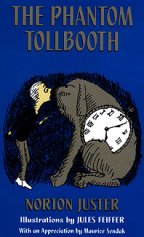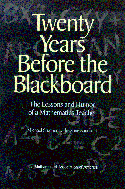




“Miss Zarves drew a triangle on the blackboard. ‘A triangle has three sides,’ she said, then pointed to each side. ‘One, two, three.’ She drew a square. ‘A square has four sides. One, two, three, four.’
“She walked around the cow to the other side of the board. She drew a pentagon, a hexagon, and a perfect heptagon.”
There it was: a little mathematics lesson in the middle of a storybook, Wayside School Gets a Little Stranger by Louis Sachar. I was reading the book to our children, and Kenneth, who was 6 years old at the time, had to interrupt. “What’s a heptagon?” he wondered. He didn’t ask what a cow was doing in the classroom. That was part of the wackiness you could expect at Wayside School. The book promptly answered his question: A heptagon has seven sides.
However, it was the next paragraph that really stuck in my mind because it nonchalantly captured one of those little truths of classroom life. Sachar wrote: “Miss Zarves was very good at drawing shapes. When most people try to draw heptagons, there is always one side that sticks out funny. But Miss Zarves’s heptagon was perfect. Every side was the same length, and every angle the same degree.”
Of course, she had drawn a regular heptagon. But that refinement merely enhanced the wonder of her singular talent.
A few months earlier, we had enjoyed another book that featured mathematics even more prominently. Math Curse by Jon Scieszka and Lane Smith neatly spoofs the types of word problems that educators and textbook writers invent to dress up arithmetic exercises and, supposedly, to demonstrate the relevance of mathematics to everyday life.
Eric, who was eight and in the third grade, laughed loudly through much of the book. He particularly enjoyed the following example:
“The Mississippi River is about 4,000 kilometers long. An M&M is about 1 centimeter long. There are 100 centimeters in a meter, and 1,000 meters in a kilometer.
“Estimate how many M&Ms it would take to measure the length of the Mississippi River. Estimate how many M&Ms you would eat if you had to measure the Mississippi River with M&Ms.”
Scieszka and Smith weren’t the first ones to tackle Mississippi math. More than 100 years earlier, in Life on the Mississippi, Mark Twain discussed the river’s penchant for shortening its length from time to time when a straight, new channel cut off a deep bend.
Twain noted that in 176 years, the Lower Mississippi had shortened itself by 242 miles, a rate of just over 1.3 miles per year. Thus, he reasoned, a million years ago, the river was at least 1.3 million miles long and “stuck out over the Gulf of Mexico like a fishing rod.” By the same token, in 742 years, “the Lower Mississippi will be only a mile and three-quarters long.”
Twain concluded, “There is something fascinating about science. One gets such wholesale returns of conjecture out of such a trifling investment of fact.”
Canadian political economist and humorist Stephen Leacock also had fun with some of the peculiarities of “concrete problems” often used in classroom mathematics. In a piece titled “A, B, and C–The Human Element in Mathematics,” which was one of a collection of comic stories originally published in 1910 under the title Literary Lapses, Leacock wrote:
“The student of arithmetic who has mastered the first four rules of his art and successfully striven with money sums and fractions finds himself confronted by an unbroken expanse of questions known as problems. These are short stories of adventure and industry with the end omitted and, though betraying a strong family resemblance, are not without a certain element of romance.
“The characters in the plot of the problem are three people called A, B, and C; the form of the question is generally of this sort: ‘A, B, and C do a certain piece of work. A can do as much work in one hour as B in two or C in four. Find how long they work at it.'”
Drawing on clues tucked away in the myriad problems featuring A, B, and C, Leacock reconstructed the tragic, misspent lives of these characters. “Now to one who has followed the history of these men through countless pages of problems, watched them in their leisure hours dallying with cordwood, and seen their panting sides heavy in the full frenzy of filling a cistern with a leak in it, they become something more than mere symbols,” Leacock mused. “They appear as creatures of flesh and blood, living men with their own passions, ambitions, and aspirations like the rest of us.”
Books and articles that base their humor on mathematical quirks and quibbles don’t come along very often. One handy, though difficult-to-find collection of mathematical poems, cartoons, jokes, anecdotes, and puzzles is the booklet called Mathematics and Humor, published in 1978 by the National Council of Teachers of Mathematics.
Additional examples can be found in the more recent book Twenty Years Before the Blackboard, in which mathematics teacher Michael Stueben describes his use of mathematical humor and curiosities as a way to enliven his classes.
Fortunately, several wonderful collections of stories, essays, and poems featuring mathematical themes were reprinted several years ago. You’ll find it well worthwhile taking a look at Fantasia Mathematica and The Mathematical Magpie, both edited by Clifton Fadiman, and the fourth volume of The World of Mathematics, edited by James R. Newman.
Stephen Leacock’s story about A, B, and C appears in The Mathematical Magpie. Two other Leacock stories related to mathematics, “Mathematics for Golfers” and “Common Sense and the Universe,” appear in The World of Mathematics. Interestingly, Leacock starts off his commentary on cosmology and modern physics by quoting Mark Twain’s speculations on the Mississippi River.
There is also some humor among the stories featured in another recent anthology, Imaginary Numbers, edited by William Frucht.
Louis Sachar, author of Sideways Stories from Wayside School and its sequels, has written two books that feature arithmetic problems and logic puzzles in the guise of wacky stories: Sideways Arithmetic from Wayside School and More Sideways Arithmetic from Wayside School.
Hans Magnus Enzensberger weaves intriguing sequences of numbers (and snippets of mathematics involving infinite series, binary numbers, primes, probability, and other topics) into an engaging tale in his book The Number Devil.
For a more up-to-date take on mathematics, check out episodes of the TV series The Simpsons for surprisingly frequent references to math topics and vocabulary. But you have to watch or listen closely to catch most of them. The pace can be so quick that they easily zip by unnoticed. See http://www.mathsci.appstate.edu/~sjg/simpsonsmath/ for a guide to mathematics in The Simpsons.
For old movie buffs, the routines of the comics Bud Abbott and Lou Costello sometimes contain wacky mathematical exercises.
My favorite mathematical spoof is in The Phantom Tollbooth by Norton Juster. The book is about a boy named Milo, who is traveling in a strange land, accompanied by the Humbug and Tock (the dog who ticks). In one episode, on the road to Digitopolis, Milo encounters not only the Dodecahedron (a mathematical shape with 12 faces) but also the mysterious, somewhat forbidding Mathemagician. Prompted by the Mathemagician, Milo plunges into the intricacies of arithmetic, the paradoxes of infinity, the absurdity of averages, and other mathematical surprises.
At one point, Milo meets the fraction of a child that completes the average family, which consists of a mother, a father, and 2.58 children. After discussing the meaning and relevance of averages, the child remarks, “. . . one of the nicest things about mathematics, or anything else you might care to learn, is that many things which can never be often are . . . . it’s very much like your trying to reach Infinity. You know that it’s there, but you just don’t know where–but just because you can never reach it doesn’t mean that it’s not worth looking for.”
Humor has a place in the mathematics classroom. The smiles or laughter that accompany a mathematical joke, cartoon, or anecdote signal understanding gained and lessons learned.
The examples I have cited, from drawing geometric figures to deciphering word problems, also serve as gentle reminders that there is a difference between mathematical exercises disguised as episodes of everyday life and real mathematics applied in the real world. It’s a distinction that’s not always apparent in the mathematics classroom.






